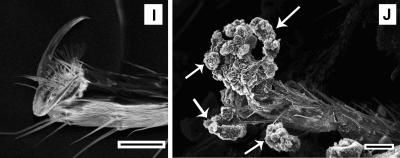Researchers film a chemical reaction and confirm a theory
Researchers from Korea, Italy, France and the ESRF have observed how a molecule in a liquid changes structure after being hit by a short flash of laser light, and how this process triggers a chemical reaction. Thanks to very intense pulses of X-rays from the synchrotron and novel data analysis, they were able to confirm a long standing hypothesis on the chemical reactivity of molecules of this kind. The results are published today in Science Express, the online counterpart of the journal Science.
The experiment starts by dissolving the molecule C2H4I2 in liquid methanol and then hitting it with a short laser pulse. This excites the molecule, which then either cools down while releasing energy to the surrounding liquid, or breaks down triggering chemical reactions. The researchers studied the time evolution of these processes with pico-second time resolution. They measured the change in shape of the molecule and the concentration of the different molecule residues as early as 100 pico-seconds after the initial explosion, then at 10 nano-seconds after, then 1 micro-second and so on. All these dancing molecular fragments are confined to a tiny "dance floor" of about 0.6 nanometres radius, formed by the surrounding solvent molecules.
Once excited by the laser pulse, one of the bonds in the C2H4I2 molecule is elongated, and the molecule's fate can follow two distinct paths. In one case, the molecule goes back to the initial ground-state of C2H4I2 surrounded by solvent molecules. In the second case, the excited C2H4I2* molecule dissociates and forms two radicals: C2H4I and I. Hypotheses about the structure of the C2H4I radical present two versions. The first possibility is that the radical retains a classical structure very similar to the initial structure of C2H4I2 - the anti-structure). The second possibility is that the iodine combines with the two carbon molecules in a triangular geometry - the bridge-structure. The new measurements indicate that the bridge-structure prevails, and this supports a theory advanced to explain stereochemical control: this theory however had never been confirmed experimentally because this radical is so short-lived. This is now possible at the ESRF thanks to the unique capability to perform time-resolved X-ray structural determinations with time resolution in the typical domain of chemical reactions. This research is the outcome of two-years of work involving a Korean research group from KAIST lead by Hyotcherl Ihee and the ID09B team lead by Michael Wulff.
Researchers at the ESRF had already studied the dissociation of molecular iodine some months ago and defined, theoretically and experimentally, the principal reaction channels in photo-reactions in this family of liquids. This new work is an important step forwards since C2H4I2 is a larger and more complex molecule than I2 and more importantly, its photo-reaction proceeds though novel molecular structures that have never been seen before. This research opens a new door to the study of chemical reactions in liquids. Hyotcherl Ihee, first author of the paper, believes there is a lot of future using this technique: "We envisage expanding it to study other samples, such as nano-materials and proteins".
Ihee et al., Ultrafast X-ray Diffraction of Transient Molecular Structures in Solution, Science Express, 14 July 2005
Most read news
Other news from the department science

Get the chemical industry in your inbox
By submitting this form you agree that LUMITOS AG will send you the newsletter(s) selected above by email. Your data will not be passed on to third parties. Your data will be stored and processed in accordance with our data protection regulations. LUMITOS may contact you by email for the purpose of advertising or market and opinion surveys. You can revoke your consent at any time without giving reasons to LUMITOS AG, Ernst-Augustin-Str. 2, 12489 Berlin, Germany or by e-mail at revoke@lumitos.com with effect for the future. In addition, each email contains a link to unsubscribe from the corresponding newsletter.


























































